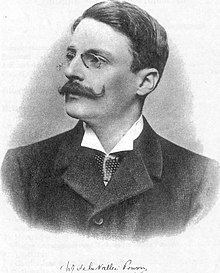Name Charles de | Role Mathematician | |
 | ||
Died March 2, 1962, Brussels, Belgium Parents Charles-Louis-Joseph-Xavier de la Vallee-Poussin Books Cours D\'analyse Infinitesimale | ||
Charles-Jean Étienne Gustave Nicolas Le Vieux, Baron de la Vallée Poussin (14 August 1866 – 2 March 1962) was a Belgian mathematician. He is best known for proving the Prime number theorem.
Contents

The king of Belgium ennobled him with the title of baron.
Biography
De la Vallée-Poussin was born in Leuven, Belgium. He studied mathematics at the Catholic University of Leuven under his uncle Louis-Philippe Gilbert, after he had earned his bachelor's degree in engineering. De la Vallée-Poussin was encouraged to study for a doctorate in physics and mathematics, and in 1891, at the age of just 25, he became an assistant professor in mathematical analysis.
De la Vallée-Poussin became a professor at the same university (as was his father, Charles-Louis-Joseph-Xavier de la Vallée-Poussin, who taught mineralogy and geology) in 1892. De la Vallée-Poussin was awarded with Gilbert's chair when Gilbert died. While he was a professor there, de la Vallée-Poussin carried out research in mathematical analysis and the theory of numbers, and in 1905 was awarded the Decennial Prize for Pure Mathematics 1894–1903. He was awarded this prize a second time in 1924 for his work during 1914–23.
In 1898, de la Vallée-Poussin was appointed as the correspondent to the Royal Belgian Academy of Sciences, and he became a Member of the Academy in 1908. In 1923, he became the President of the Division of Sciences.
In August 1914, de la Vallée-Poussin escaped from Leuven at the time of its destruction by the invading German Army of World War I, and he was invited to teach at Harvard University in the United States. He accepted this invitation. In 1918, de la Vallée-Poussin returned to Europe to accept professorships in Paris at the Collège de France and at the Sorbonne.
After the war was over, de la Vallée-Poussin returned to Belgium, The International Union of Mathematicians was created, and he was invited to become its President. Between 1918 and 1925, de la Vallée-Poussin traveled extensively, lecturing in Geneva, Strasbourg, and Madrid. and then in the United States where he gave lectures at the Universities of Chicago, California, Pennsylvania, and Brown University, Yale University, Princeton University, Columbia University, and the Rice Institute of Houston.
He was awarded the Prix Poncelet for 1916. De la Vallée-Poussin was given the titles of Doctor Honoris Causa of the Universities of Paris, Toronto, Strasbourg, and Oslo, an Associate of the Institute of France, and a Member of the Pontifical Academy of Sciences, Nazionale dei Lincei, Madrid, Naples, Boston. He was awarded the title of Baron by King Albert 1 of the Belgians in 1928.
In 1961, de la Vallée-Poussin fractured his shoulder, and this accident and its complications led to his death in Watermael-Boitsfort, near Brussels, Belgium, a few months later.
A student of his, Georges Lemaître, was the first to propose the Big Bang theory of the formation of the Universe.
Work
Although his first mathematical interests were in analysis, he became suddenly famous as he proved the prime number theorem independently of his coeval Jacques Hadamard in 1896.
Afterwards, he found interest in approximation theory. He defined, for any continuous function f on the standard interval
where
and
are the vectors of the dual basis with respect to the basis of Chebyshev polynomials (defined as
Note that the formula is also valid with
Finally, the de la Vallée-Poussin sums can be evaluated in terms of the so-called Fejér sums (say
The kernel is bounded (
Later, he worked on potential theory and complex analysis.
«Cours d’analyse»
The textbooks of his mathematical analysis course have been a reference for a long time and had some international influence.
The second edition (1909-1912) is remarkable for its introduction of the Lebesgue integral. It was in 1912, “the only textbook on analysis containing both Lebesgue integral and its application to Fourier series, and a general theory of approximation of functions by polynomials”.
The third edition (1914) introduced the now clasical definition of differentiabilily due to Otto Stolz. The second volume of this third edition was burnt in the in fire of Louvain during the German invasion.
The further editions were much more conservative, returning essentially to the first edition. Starting from the eight edition, Fernand Simonart took over the revision and the publication of the Cours d’analyse.
